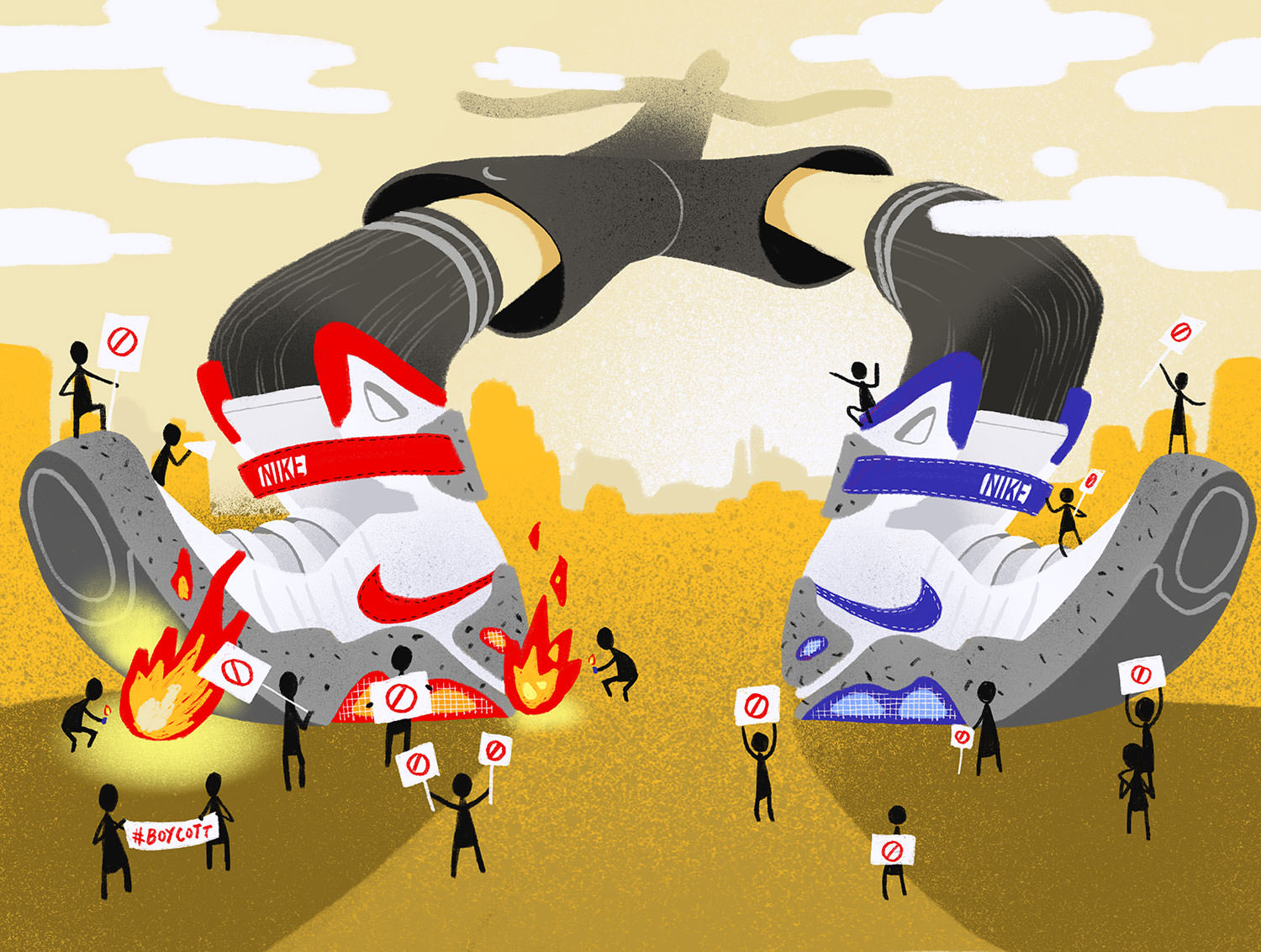
I’m currently being trained as a Christian social ethicist in a doctoral program. One of the most important lessons I’ve learned so far is that although Christians often assume we “already know” how to discern right from wrong — ethical versus non-ethical ways of doing and being — making ethical choices is more complicated than we think. And ethical choices in the context of a capitalist world that’s constantly conditioning our desires, informing our “needs”, and shaping our behavior are especially complex.
For example, many of us use “love” as a guiding rubric for discerning right from wrong. Jesus taught us that of all the laws, the greatest law is love. But what does the practice of love actually look like, and how do we know it’s being achieved? Martin Luther King Jr. defines love this way: “Power without love is reckless and abusive, and love without power is sentimental and anemic. Power at its best is love implementing the demands of justice, and justice at its best is power correcting everything that stands against love.” And indeed, discerning “right” from “wrong” requires a power analysis. Who holds the power in this situation? Who does this benefit? Who does this harm?
This past September, Nike claimed Colin Kaepernick as the face of its “Just Do It” 30th Anniversary campaign. The move struck many as a bold political stance positioning Nike as “moving the country forward” on the issue of racial justice in the United States. While there’s no mention of police brutality against Black bodies — the issues that Kaepernick has been kneeling on behalf of — in said ad campaign, displaying Kaepernick’s face on their ads evokes the emotions of anti-racist resistance that have come to be associated with him.
In the days following the release of Nike’s Kaepernick ad, CNN aired an interview with actress Jennifer Lewis on the red carpet at the Emmys where she said, “I am wearing Nike tonight to tell them how proud I am of them for supporting Colin Kaepernick and his protest against police brutality and racial injustice. I speak to the millennials tonight to tell them they are not alone in standing up. We’re right behind them. Their ancestors are behind them who took two knees and two hands picking cotton.” In Lewis’ reflections, Nike’s decision to use Kaepernick’s image for its ad campaign has aligned them with anti-racist activism addressing the historic roots of racial capitalism in the enslavement of African peoples.

Of course, Nike’s decision to support Kaepernick sparked an immediate reaction on the right, with many calling for a Nike boycott or posting photos and videos of themselves destroying their Nike products. Many who opposed Nike’s decision to support Kaepernick even began taking up the anti-sweatshop labor cause — at least on Twitter — and now I’ve even found myself reluctant to “retweet” posts about Nike’s maltreatment of factory workers in Southeast Asia for fear that I’ll be associated with Trump-supporting Twitter accounts now sharing those same facts.
Meanwhile, Nike is significantly funding the Republican Party, ensuring Republicans maintain control of Congress in the 2018 elections. In 2018, the bulk of Nike money went to the National Republican Congressional Committee and to the National Republican Senatorial Committee, both of which are committed to protecting their “historic republican majority”.
While Nike’s stock prices took a slight dip after releasing the Kaepernick ad, they’re now at an all-time high as profits have continued to rise since releasing the ad. It seems Nike knew the ad would resonate with the company’s core customer base. In the wake of the campaign, Nike gained around 170,000 followers on Instagram, and the Kaepernick ad has drawn a record number of likes and comments.
In discussing the new Nike ad campaign with my own friends, many agreed that this move was positive overall. The feeling seems to be that Nike has enough power to “make a difference” and shift the white American conscience on issues of police brutality against Black communities, so this is a step forward in the struggle against racism in the United States. Some remarked that they would at least rather live in a society where large corporations are publicly siding with racial justice rather than with bigotry and white supremacy. Regardless, Kaepernick deserves to get paid after all he’s sacrificed. Still others felt that the ad was “inspiring”, and we need inspiration right now.
Let’s be real here. Many felt that we can’t possibly escape capitalism, so resistance always and only happens in complex, multi-headed systems and is therefore always compromised. Some concluded this was a case of “both/and” — we can vehemently oppose global capitalism and celebrate Nike’s decision to endorse Kaepernick; we can watch the Nike ad over and over again for inspiration and understand that Nike isn’t salvation or revolution.
But what is the way forward?
I personally felt hurt by this Nike/Kaepernick moment because I consider poor Asian women to be my people. When the scholars and activists I most admired were posting and celebrating the Nike ad, I felt a familiar sinking feeling — why was some major corporation succeeding at furthering the movement for Black liberation at odds with movements resisting the ravages of capitalism, which mostly impacts poor women of the Global South?
What does “love” mean in this context? Who has the power? Who does this benefit? Who does this harm? We often assume ethical choices are clear — that we know how to morally “be”, and what to morally “do”. But what about when violence is subtle, hidden, insidious? And what’s at stake in our ethical confusion?
Currently, after producing for Nike for 17 years, 1,500 unionized workers in Indonesia — primarily Muslim women — are about to lose their jobs so that the company can switch to cheaper labor. This is just the start of Nike’s plans to pull 30,000 jobs from the country that built its empire. And all over the Global South, particularly Asia, people who work in Nike factories are still being paid a poverty wage even though Nike can afford to pay more. Nike has refused to collectively bargain with trade unions. Despite worker grievances in places such as China, Vietnam, and Indonesia, key issues have not been addressed. Factory workers in Indonesia have reported that wages are not enough to meet basic needs. Nike frequently pulls production of their apparel factories, refusing to follow local laws about how companies ought to ethically shut down a factory with minimal harm.
Our current system of global capitalism requires that poor women of the Global South not be seen or considered within the realm of human moral worth. For Nike to produce products and profits at the scale that it does requires the world not to think about certain laborers, certain faces, certain people. For the system to continue as it does, we need to accept the reality — usually unconsciously, as there are many institutions in place to guarantee that these faces don’t enter our conscious minds — that the lives of certain poor, young South and Southeast Asian women do not matter. These certain poor, young South and Southeast Asian women matter only insofar as they keep working at an inhumanely fast pace. They matter only insofar as they pull their tired bodies out of bed in the morning, kiss their children quickly, and show up to keep factory production moving.
You may remember Nike being in the media for horrendous sweatshop labor conditions in the 90s. You may remember images of young, poor exploited Asian women, with stories about unlivable wages, extremely long hours, unchecked sexual abuse, the gap between worker treatment and company profits, and stories of women collapsing at their machines.
But Nike has successfully turned around its image since then, and many have either accepted sweatshops exploiting young, poor Asian women as an inevitable and unavoidable aspect of our global economy, or assumed that things have gotten better. And assuming things have gotten better wouldn’t come from nowhere since central to Nike’s business model has always been outsourcing its manufacturing and using the money it saves on brilliant marketing campaigns. After the exposure of its sweatshop abuses caused marked drops in sales, Nike created the Fair Labor Association in 1999 — an organization tasked with auditing Nike contracted factories for labor violations and to address worker maltreatment cases. However, Nike has not agreed to allow independent, non-Nike sponsored organizations to monitor the company, even though comparable brands like Adidas have agreed to independent inspections.
In 2016, Noi Supalai, a former Nike garment worker and 44-year old mother of two came to the United States and embarked on a nationwide tour with the United Students Against Sweatshops, a national student-advocacy group. She’d worked in Thailand in a garment-making factory. The factory employed about 2,000 workers and formed contracts with brands such as Columbia Sportwear, The North Face, and Nike, producing jackets primarily for European and American buyers. When she began working at the factory in 2008, she worked from 8 a.m. until 5 p.m., with a one-hour break for lunch. She was paid $4 to $5 per day, plus voluntary overtime. And for Supalai, this initial wage was reasonable. Supalai explains that after the factory received a contract with Nike in 2009, however, many changes began to occur.
Workers were pressured against time, hours were changed, workers were expected to work until midnight — sometimes even to sunrise — and breaks were minimal. Workers couldn’t see their families and many worked themselves to exhaustion. But she and her co-workers didn’t fight back until after all of this, the workers did not receive their monthly paychecks and found their lives in danger. Their factory employers explained that they could not pay workers until Nike paid for their order. But without wages, workers couldn’t cover their rent, electricity, food, or running water.
It was in this moment that Noi Supalai was elected president of their union and they began organizing to resist this treatment and appeal directly to Nike for help in claiming their wages. However, after Nike representatives spoke with Supalai and her union, assuring them that they would meet with Eagle Speed managers, Nike instead retracted its orders from the company. Apparently, this “cutting and running” practice is a common business practice where companies contract with companies abroad but remove orders and break contracts once workers organize and demand basic rights. When this happens, brands like Nike often swiftly move their production to a different factory with less regulation.
These experiences confirmed for Supalai and her co-workers that Nike prioritizes profit over the very basic rights of the people producing their products to get paid. In her words, “they don’t care what they leave behind, our working conditions, the conditions of the workers, or what would happen to the factory. The only thing they care about is their products and their profits.” Supalai urged students to advocate for the people working behind the production of big brands. She expressed that this kind of support encourages workers to stand up for basic rights on their side, too.
Our struggle for justice and righteousness cannot be limited to the borders of the United States; all our struggles are intertwined. Struggles for justice in the United States must support Kaepernick and garment workers around the world who produce for Nike and are calling on us to support their struggle. Do not be deceived — we cannot allow the emotions associated with Kaepernick’s stance against racist police brutality to be harnessed and disciplined into consumer behavior. We must remain vigilant in the work of creating the world we long for, listening most intentionally to the voices of those most impacted by structures of domination and violence, and doing the daily work of struggling for love and justice in all our families and communities.

Lisa Asedillo Pratt is a doctoral student at Drew Theological School and studying Christian social ethics in the religion and society area. She is also an assistant pastor at New Day Church in the Bronx, New York. Lisa’s primary research interests include intercultural, Asian American, and feminist ethics, postcolonial theory, and liberationist thought. She also loves poetry, running, community building, and anything Grace Lee Boggs.

John Enger Cheng serves as creative director of Inheritance. He is a Los Angeles-based artist, designer and illustrator. He graduated from the University of Southern California Roski School of Fine Arts and is co-founder of Winnow+Glean. You can see his illustrative work and store at madebyenger.com.